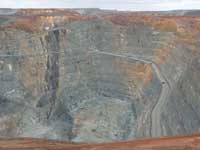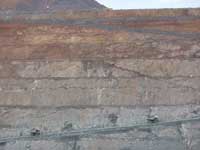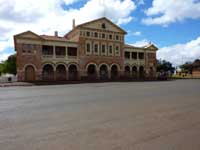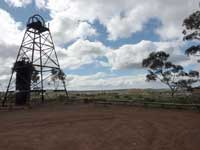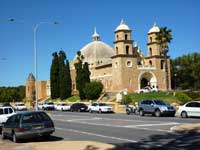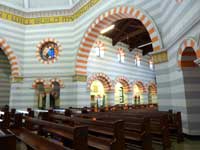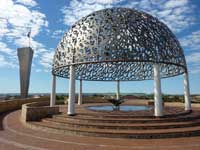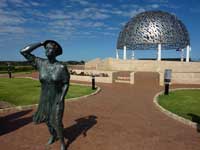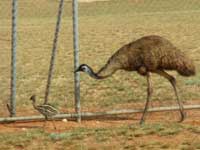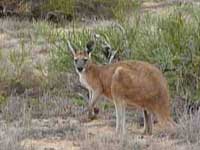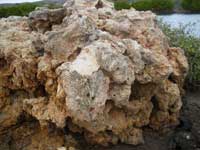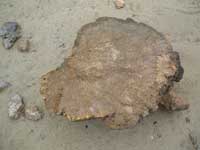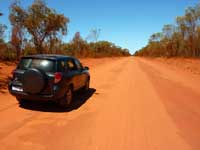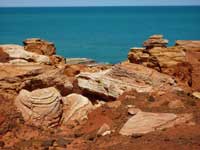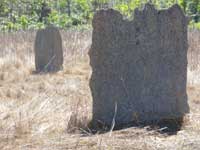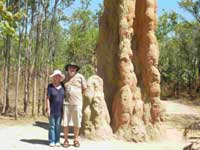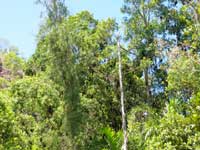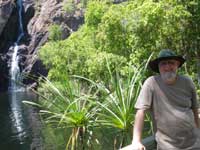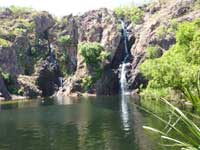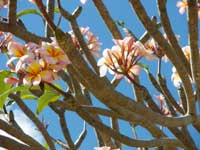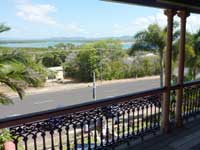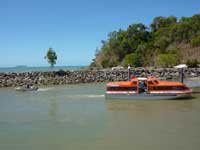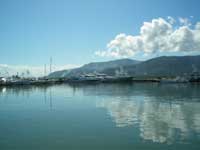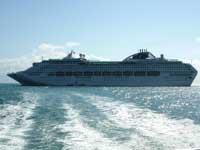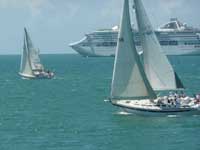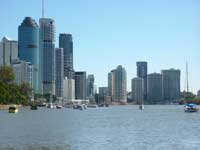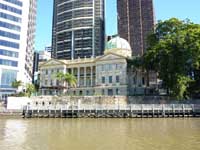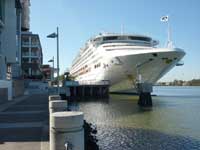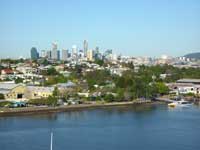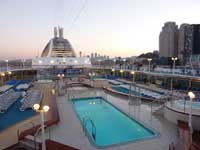Around the top of Australia from Fremantle to Sydney on Sun Princess in August and September 2009
Over the Top of Oz (download 565KB PDF file) | Map
OVER THE TOP OF OZ
This is really the story of a wonderful cruise on the good ship 'Sun Princess' but before joining her, we took a side trip to Kalgoorlie. Why? Because it was there, to coin a phrase and because ever since learning about this mysterious gold mining town in the middle of nowhere and being fascinated with its name when she was about seven years old, Sarah has wanted to visit it.
Kalgoorlie, Western Australia
Kalgoorlie is some 600km east of Perth, Western Australia and we travelled there by train, which took seven hours as passenger trains have to give way to freight - of which there are many. The almost totally unchanging countryside for virtually the whole journey gave us an appreciation of the term GABA, which our Australian friends tell us stands for the Great Australian B****r All!
The town is distinguished by its 'Superpit', the largest hole in the world, visible from space. This is the open-cast goldmine which is the town's entire raison d'être, as has been the case since the late 1800s when the first gold rush brought prospectors to Australia from all over the world.
We were suitably awe-struck by the sheer size of the pit - Lorries carrying 250 tons of ore looked like mere ants and humans simply disappeared, so small were they in proportion to the giant machinery and the pit itself. We also visited the excellent Mining Museum with the exhibits showing the history of mining as well as the pulling of sandalwood, the other source of the town's riches, which we found most interesting. We were glad that the Mining Museum was open because we had made the mistake of being there at the weekend and the rest of Kalgoorlie was closed! It was like a ghost town with neither people nor cars on the ultra-wide streets, which were designed that way to allow camel trains to turn round in their width.
The lack of bustle was a little disconcerting to begin with but we appreciated it as it enabled us to see the magnificent buildings which adorn the town. Ornate Victorian 'palaces', built of wood, with colonnaded balconies, frilled with wrought iron filigree-work are to be seen on every corner and it didn't take long to spot that these were almost all 'hotels' (pubs, in other words).
It was in one of these that we found our dinner (and the only other people we saw), which was best described as 'hearty'. Sarah ordered a pork cutlet and was presented with two, inch-thick, pork chops larger than Martin's hand, a garden full of vegetables and potatoes and a lake of mustard sauce, totally over-facing her appetite; we did wonder what breed of pig could have produced such gargantuan cuts! Martin's prawn dish was marginally more modest, but still equivalent to two portions anywhere else. Perhaps those hard-working and hungry miners need feeding up?
We had exhausted Kalgoorlie but still had another day to fill so we set
off, in our hire car, for the nearby gold-town of Coolgardie. This was
even quieter than Kalgoorlie but interesting for the contrast in architectural
styles. Again, there were the wide streets, to accommodate those camels
but here the buildings, although contemporary with those in Kalgoorlie,
were built of brick and this gave the town a very elegant, prosperous
appearance. Coolgardie enjoyed its heyday at the end of the 19th century
but the gold ran out and Kalgoorlie overtook it as the main gold mining
centre, which it remains today.
The next morning, we took the early flight to Perth, 50 minutes against
the seven hour train journey, and arrived in time for breakfast and a
day of shopping and looking round the city.
On Tuesday 25th September we joined the ship and set sail on our trip from Fremantle to Sydney going 'Over the top', which is the 'wrong way round', according to yachtsmen as the winds and tides would be against us. In the event, we had the smoothest trip of any cruise we have been on and perfect weather all the way! 'Sun Princess' is one of the larger ships in the Princess fleet, carrying some 3500 souls, including crew. She is as luxuriously appointed as her sister ships and the quality of the food and wine was second to none. The entertainment was unusually good, as were the resident lecturers who gave us an insight into the places we visited and also the difficulties of taking a ship of that size through the shallow waters and reefs which abound in those seas. The resident musicians were good and it was an added bonus that a good variety of classical music to be enjoyed.
Geraldton, Western Australia
Our first port-of-call was Geraldton. We walked to the excellent Visitor Centre, housed in the old hospital, where we found a great deal of interesting information about both Geraldton itself and the other two Western Australia towns we would be visiting. In the grounds of the centre, there was the old gaol, which would certainly have been a deterrent to any would-be miscreant who might see it, even though it is now an 'arts 'n' craft market'! Geraldton is a fairly depressed town, although there are great efforts being made to gentrify it, especially around the waterfront area.
The town has three astonishingly impressive claims to fame. First, we visited the beautiful St Francis Xavier Cathedral, designed by the extraordinary English architect-turned-priest, Monsignor John Hawes, who later retired to live as a hermit on Cat Island in the Bahamas. The almost byzantine architecture together with some exquisite stained glass made this a very surprising building to find in dusty Western Australia!
The museum was next on our list and we were most impressed with this modern building filled with superb exhibits, expertly displayed and explained to give the best possible lesson in the history of not just the area, but Australia as a country, particularly the rise of the European settlers and the lot of the Aboriginal people (not a happy tale - then or now, alas). There was a great deal about shipwrecks and the artefacts found on them, with some terrific reconstructions to wonder at. It has been our experience throughout our travels in Australia over the years that even the smallest town has a museum and art gallery of world-class standards and Geraldton is no exception.
The last but by no means least - far from it - of the three attractions of the town is the HMAS Sydney memorial. This most moving of memorials commemorates the 645 men of the Royal Australian Navy ship which was lost in a skirmish with the German vessel Kormoran off the coast of Geraldton in 1941. The memorial is a giant globe made up of 645 seagulls, with a perpetual flame burning within, with the poignant figure of a woman looking out to sea.
Exmouth, Western Australia
Exmouth was our next port and here we had arranged a hire car as we particularly wanted to explore the world heritage Ningaloo Reef and Cape Range National Park, especially Yardies Creek, renowned for its fossils. On our way through the town, we encountered a mother emu with her mischievous chick, which was not something we expected to see along a busy street! Later in the day we saw several others including a family of four for whom we had to stop so that they could cross the road in front of us. We also saw several kangaroos throughout the day, none of which showed the slightest fear of, or interest in, us so we were able to observe them quite closely.
We had hoped to take a boat trip up the Creek but unfortunately some socking great cruise ship was in and all the tours had been booked out by them! We don't tend to take the organised tours from the ship as they are ruinously expensive and indeed, when we saw what our fellow passengers had been charged compared with the cost of the trip, we were horrified. Although we missed out on the boat ride, we saw plenty of interesting fossils and did not feel too hard done by.
When the sun shone on it, the reef was spectacular for the brilliance of the colours in the water - ranging from palest blue-white through the richest turquoise to deep, marine blues and greens. At the Visitors Centre, we saw a wonderful video of the sea life beneath the waves and although we don't dive ourselves, thought of Sallie and Paul and understood how much they would love to have been there, diving with whales, sharks, dolphins and dugongs amongst all the other tropical fish which abound in these protected waters. Upon our return to the ship, we were enchanted to see whales spouting and breeching a couple of hundred metres away and we watched them until they disappeared - such a treat!
Broome, Western Australia
The prosperous town of Broome was next on the itinerary and here, again, we hired a car. We drove out to the Broome Bird Observatory, some 25km distant along red sand tracks (Avis kindly gave us a 4-wheel drive at no extra cost when we said we wanted to go there), where we saw very few of the water fowl for which it is so famous - possibly as it was nearly mid-day by the time we got there and they may prefer the dawn or dusk time. We did, however, see several species of forest bird which were new to us, from the 'hide' in the woods, so all was not lost ... and that drive was an experience in itself!
Back near the town, we visited the crumbly sandstone cliffs where dinosaur footprints (they're surprisingly small) have been found and then took ourselves to the famous Matso's Café and Brewery where their home-brewed ginger beer proved most refreshing. Broome's prosperity is built on pearl diving and there is an excellent museum featuring two old pearl luggers as well as an interesting exhibit of the paraphernalia of the industry from earliest times to the present day. We watched the sunset over Cable Beach, where we had earlier walked among the ibises, then set sail for The Kimberley.
The Kimberley Coast, Western Australia
After the better part of a day, sailing between the small islands of the Buccaneer Archipelago, we arrived at The Kimberley. This is a huge, almost unpopulated, little-travelled, rugged area of deep chasms and rocky outcrops, great rivers (home to the deadly saltwater crocodile) and bulging-trunked boab trees. We, of course, were only able to explore the deeply indented coastline but the perfect stillness and silence of the fjord-like York Sound gave an idea of the remoteness of the area. We cruised around the Sound for a couple of hours until sunset, which produced the most beautiful colours in the red rock. If you have seen, or read about, these colours in Ayers Rock (Uluru), you will have some idea of what we saw.
Darwin, Northern Territories
Our next port was Darwin where we had booked the only 'official' tour of the trip. We very much wanted to visit the litchfield National Park and as this is some 150km from the city we decided that it was too risky to hire a car and go it alone in case of a break down or other mishap. We have never, touch wood, had such a calamity but since the ship will not wait for any late-comers, unless they are on one of the ship's own organised tours, we were not prepared to take the chance of being left behind. En route to the park we drove through a very interesting settlement called Batchelor, where we saw the most encouraging signs that the Aboriginal people are taking charge of their own future and that of their children and beginning to accept that they must work in order to survive in the modern world. In this place, all the women have the opportunity to have a college education or vocational training of some sort - the men of this and past generations have proved a 'lost cause', alcohol, which the Aboriginal physiology does not handle well, and government hand-outs being more attractive. These women, guaranteed jobs which they are proud to hold down, in turn teach their children, male and female, the importance of the work ethic and so the cycle of dependence will, eventually, be broken. The township was immaculately tidy, with prettily planted gardens and well kept houses and it was a great source of pride that they had won the Australian Best Kept Township award - previously unheard of for an Aboriginal settlement.
Kakadu National Park is very famous (largely thanks to Crocodile Dundee!) but we had been told that litchfield was every bit as good and some say even better and this, together with its proximity to Darwin, made it our choice. We particularly wanted to see the different types of termite mounds, the magnetic and the cathedral and we were not disappointed. The magnetic mounds are like jagged-topped tomb stones, slab sided but very shallow. They are built only in a certain area of grey soil, making them look even more like gravestones, in a north-south orientation so that the wide sides catch the full heat of the rising and setting sun. The cathedral mounds, built of rich, red sandstone, can reach over 10 or 12 feet (oh, all right, 3 or 4 metres) in height and house tens of millions of ants.
We also visited two beautiful waterfalls, Wangi and Florence. We paddled in the billabong (swimming hole) at the base of Wangi Falls, refreshing hot, sticky feet while watching and listening to the thousands of bats hanging upside down in the surrounding trees. At mid-day we had the most delicious fish lunch of barbecued barramundi (an Australian speciality and ubiquitous throughout the country) with quantities of fresh salads and bread and butter followed by a wicked mango cheesecake served with Quongdong sauce. We had not heard of this fruit before and were told it is a type of very small peach which grows only in a few places in the area and South Australia...it was wonderful and we regret not buying a bottle to bring home (visions of broken glass and sticky, red sauce over all our clothes gave us pause as we were about to purchase some... ). We were most impressed that a very basic 'caff' in the heart of the wilderness, so far from 'civilisation' was able to produce such a wonderful meal and it speaks well of their organisational skills as well as care for the tourists that they had bothered and not simply served up re-heated frozen hamburgers in buns.
While in the Park, we stood atop the table mountain and looked about us through 360o to find that as far as the eye could see (and way beyond) the terrain was exactly the same mix of shrubs and trees, with almost no habitation or sign of man's influence; that GABA again!
The journey back to the ship was less enjoyable than the rest of the day as the air conditioning on the coach broke down. Since the outside temperature was over 30oC and the coach was almost hermetically sealed (the driver managed to crack open a roof vent a little) the temperature was in excess of 40o by the time we got back to Darwin an hour and a half later. Never mind, we survived and it is just another of those little things which punctuate any journey and make it interesting! We had intended to leave the coach in the city and explore Darwin but were too hot and sticky so, as we will be there again in December, we decided to go straight back to the ship, a shower, swim and refreshment being more attractive propositions.
Cooktown, Queensland
After a couple of relaxing days at sea we arrived at Cooktown. We were last here in 1984 and it hasn't changed a bit! We took a leisurely stroll, in the shade of some beautiful, fragrant frangipani trees, along the waterfront footpath which is inlaid with tiles depicting stories and scenes from Cooktown's European history as well as the history of the Aboriginal tribes of the area. This took us into town and then to the Captain Cook Museum, which is housed in a delightful old house, with deep, shady verandahs, the roof supported by the same sort of filigree ironwork pillars we had seen in Kalgoorlie.
Everywhere we walked, the streets were shaded by massive mango trees, laden with fruit (alas, as yet unripe). It was extremely hot and we decided that an iced coffee was a more attractive prospect than a long, uphill trek to the botanical gardens. This was probably a wise decision because others who had been more conscientious in their sight-seeing arrived back very hot and bothered; the gardens having proved moderately interesting but definitely a walk too far in the climate. We returned to the ship with enough time to enjoy a swim and quick shower and change so we could attend a delightful classical concert given by the ship's excellent resident trio before dinner.
Cairns, Queensland
Yorkey's Knob (named for a Yorkshireman who did good works for the area) came next and we were tendered in to a very pretty yacht marina where shuttle buses were waiting to take us into the city of Cairns.
Unlike Cooktown, Cairns has changed beyond recognition since 1984 but although it has lost some of its old world frontier town charm, it is an attractive, vibrant, modern city which has managed to maintain a certain individuality. We explored the busy waterfront area where dirty old coasters, sleek modern tankers, naval vessels, multi-million dollar gin palaces, yachts both tall and small and little family runabout bathtubs all rub happily against each other at their moorings. The town offered the usual array of shops and one great 'find' - an old fashioned outfitters which was able to provide Martin with a good, lightweight, broad-brimmed hat and Sarah a pair of good quality, comfortable, walking sandals; we had been seeking both hat and sandals for some time. A visit to the wonderful art gallery was the highlight of the day, however, and we were delighted to discover a new artist, Helen Hume, whose work we shall seek out in future. If you are interested in learning more about her work, let us know and we'll write at greater length.
Townsville, Queensland
Our next stop was at Townsville where, because of very shallow waters, we had to anchor so far out that large, very fast catamarans were pressed into service to ferry us to and from the ship to shore, taking a good half hour each way. The ship's own tenders would have been inadequate for the task as they are comparatively slow and with about 2000 passengers to transfer, they would have taken all day to get us all off then on again! We loved the trip on the open top deck and found it quite exhilarating, though a number of grumpy souls complained bitterly about the length of the journey. We pointed out that there were scenic trips being run to and from the dock along pretty much the same route, past Magnetic Island, for which passengers were being charged $50, against our free ride!
Once ashore, we walked to the magnificent aquarium, which is very cleverly designed and incorporates actual living reef in the display. One walks through glass tunnels within the reef, with all manner of colourful corals, sea plants and fishes of all shapes and sizes, including enormous sharks, swimming all about and overhead. There are also smaller tanks of which our favourite was the one housing numerous sea horses; we love these enchanting creatures and could watch them for hours.
From the aquarium we walked into town but, sadly, found it very run down. We were surprised that the many historic buildings, of which they are obviously very proud as there are beautiful plaques on them describing their history, were in a dreadful state of disrepair, clearly not having had even a coat of paint for many, many years. There is a modern pedestrianised mall type shopping centre which is hardly tenanted at all now and is, apparently scheduled for re-development, though one fears it is already too late and the town centre has become victim of the out-of-town shopping complexes which have sprung up in the suburbs. On a more positive note, the area along the seafront has been very beautifully and sympathetically developed, making a pleasant recreation area for both the guests at the 'boutique hotels' which abound and the residents of the large houses of the neighbourhood - one would like to feel that the same amount of expense and care will now be lavished on the less well-heeled areas but somehow we doubt it.
Brisbane, Queensland
A lazy day at sea gave us time to recover from out three days ashore and then we arrived in Brisbane. We came in up the river and moored right on the edge of the city, which gave us an easy walk to the first water-bus stop of the main commuter transport, a catamaran (the CityCat), for the ride to the centre of things. Brisbane is big, brash and buzzing with vibrancy we have seen nowhere else in Australia, though they have kept some old gems in amongst the sky-scrapers. The average age of its inhabitants is 33 and it showed, particularly in the ubiquity of mobile phones glued to every ear and giving rise to shouted conversations of unutterable banality. That was the only down-side and we were very agreeably surprised at the great strides the city has made since we last visited 25 years ago, when we found it very dull.
The South Bank district is home to several excellent museums and art galleries and we particularly enjoyed the Museum of Modern Art exhibition of contemporary Aboriginal art. After walking our socks off around the galleries and through the shopping centre, we headed for the river and hopped back on the CityCat, deliberately going the 'wrong' way. This took us right through the city to the university and suburbs, then back again, all the way 'home'. We are looking forward to returning to Brisbane in December.
Our departure from Brisbane was an interesting occasion as the ship had moored facing the city but then, of course, had to turn round for our return to open sea. This was a nail-biting affair, at least for the captain, as the ship is only a bout 10 metres shorter than the river is wide - not a lot of room for error! Of course, it was achieved without mishap, earning a huge cheer from those of us on deck that had followed every minute manoeuvre. We shall be interested to see where we moor when we returning December as the ship we shall be on then, the 'Diamond Princess' is somewhat larger than the 'Sun Princess'... we do hope it will be the same berth as departure will then be an even more breath-taking experience!
Sydney, New South Wales
One more day at sea cruising along the Great Barrier Reef and watching whales for most of the day, brought us to Sydney at dawn. We were on deck at 5am (yawn!) but it was worth it to watch the sky lighten and the rosy glow light up the Opera House and the Harbour Bridge - two sights of which we never tire. This was our port of disembarkation and almost the end of our wonderful trip. We spent the day in Sydney doing touristy things like visiting Paddy's Market then in the evening, had a delicious Indian dinner with a friend whom we met on our Antarctic cruise.
We haven't said much about the ship which was our 'home from home' during the 18 days of the cruise. She is very similar to her sister ship, the 'Star Princess' on which we sailed on the Antarctic cruise in February. There are lots of quiet lounges with leather or velvet club chairs in which to curl up with a book from the small but comprehensive library as well as bigger public rooms with music and activities for those who wished to participate. We enjoyed the team quizzes and by dint of teaming up with four other managed to win or at least come second on a number of occasions. There was lots of open deck space and we spent a lot of time outside taking the air and, especially, whale-watching (and occasionally even spotting). Food was, as always, excellent, available round the clock and plentiful (too plentiful!) and this ship even had its own Trattoria where the best pizzas outside Naples are served; we had far too many lunches there. It was not as dressy as in 'the olden days' of the first 'Sun Princess', on which we took our very first cruise in 1984, but we still had three formal evenings and enjoyed scrubbing up and getting into glad rags and glitter (not so much glitter for Martin, perhaps) for those occasions. We had very agreeable table companions at our set-time dinner table and also met lots of other congenial people at breakfast and lunch, which are more casual and the seating is not fixed.
Our flight to Auckland the next day was uneventful as was the short hop back Up North, where our car was awaiting us. We drove straight to the family for a welcome-home dinner, which was, as always, the best part of any holiday!
Over the Top of Oz (download 565KB PDF file) | Map

